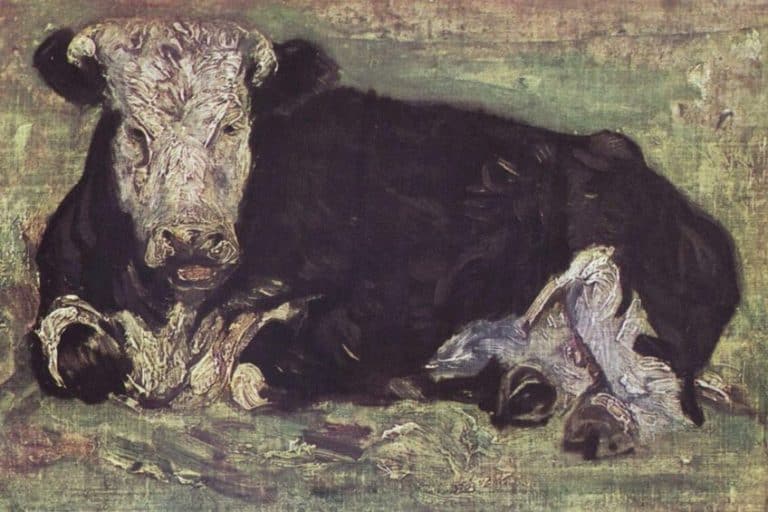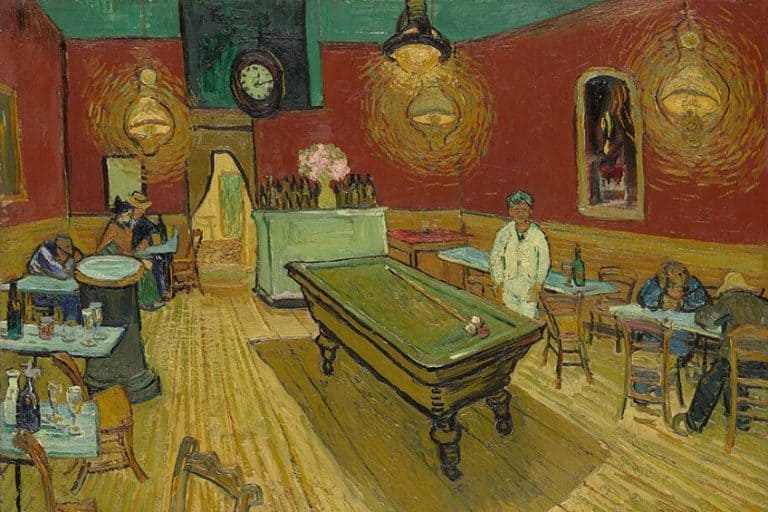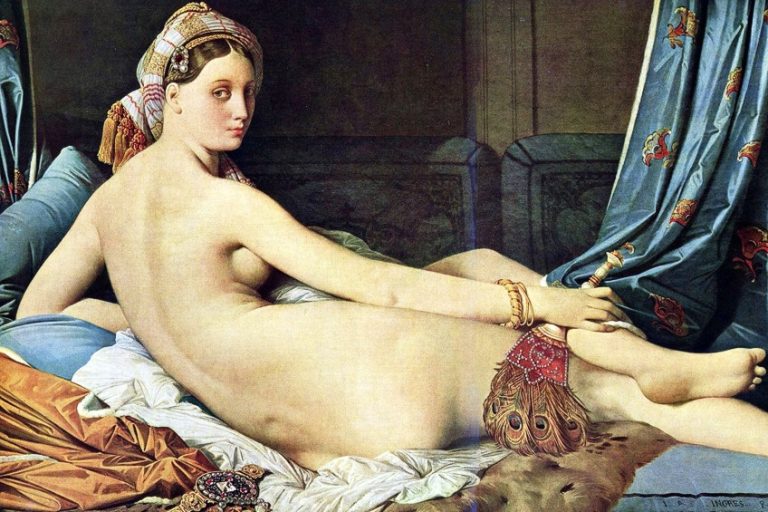The Abduction of Psyche by William-Adolphe Bouguereau – A Look
The Abduction of Psyche (1895) by William-Adolphe Bouguereau depicts two famous sweethearts from Greek mythology, namely Psyche and Cupid. In the article below, you will learn more about this painting and its two main protagonists that are shown in a loving embrace.
Artist Abstract: Who Was William-Adolphe Bouguereau?
William-Adolphe Bouguereau’s birthplace was in the French city of La Rochelle and he was born on November 30, 1825. He died in his birth city on August 19, 1905. Raised as a Catholic, he attended a Catholic college during his early teenage years and was also educated in drawing by Louis Sage, who was a Neoclassical artist. When Bouguereau moved to Paris at 20 years old he also studied art under François-Édouard Picot, another Neoclassical artist.
He also attended the École des Beaux-Arts.

During his life, he studied various other subjects like theology, anatomy, and sculpture, among others. He also traveled to Rome after winning a Grand Prix de Rome in 1850. His paintings include The Birth of Venus (1879), Dante and Virgil in Hell (1850), and Dawn (1881).
The Abduction of Psyche (1895) by William-Adolphe Bouguereau in Context
| Artist | William-Adolphe Bouguereau |
| Date Painted | 1895 |
| Medium | Oil on canvas |
| Genre | Mythological painting |
| Period/Movement | Academic art/Neoclassicism |
| Dimensions (cm) | 209 x 120 |
| Series/Versions | N/A |
| Where Is It Housed? | Part of a private collection. |
| What It Is Worth | The exact price is uncertain. |
The Abduction of Psyche painting analysis below will start with a brief overview of the origin of the mythological tale, which will be followed by a visual description of the painting itself and a closer look at the art elements that compose it, which will highlight the artist’s unique Academic art style.
Contextual Analysis: A Brief Socio-Historical Overview
The Abduction of Psyche meaning starts with its title, which is L’enlѐvement de Psyché in French. This translates to “The Rapture of Psyche”, which also changes how this painting would be understood. Is Psyche really being abducted or is she in a state of rapture or ecstasy? Let us look at the story behind Psyche and Cupid to understand why she was abducted and in rapture. Bouguereau depicted the mythological scene based on the story written by Lucius Apuleius Madaurensis, who was a Roman author, titled Metamorphoses (2nd century AD).
In this text is the story of Psyche and Cupid, and the couple’s journey from Psyche’s marriage to a monster to eventually her heavenly union with Cupid. Psyche was known to be exquisitely beautiful, and the goddess Venus was jealous of this beauty.

Venus ordered her son Cupid to make Psyche fall in love with a being that was horrendous, and so Psyche’s take unfolded that her parents had to take her to a mountaintop to let her go to her fate. However, cupid fell in love with Psyche and abducted her to a new home where eventually Psyche learned that it was him. After several trials, Cupid and Psyche eventually found their way to one another and Psyche was transformed to live immortally with Cupid.
Formal Analysis: A Brief Compositional Overview
The formal analysis will start with a visual description of the subject matter in The Abduction of Psyche by William-Adolphe Bouguereau. It will then discuss how the artist utilized colors, texture, line, shape, form, and space, which are the dominant elements of art. It will also mention what principles of art are utilized.

Subject Matter: Visual Description
The Abduction of Psyche by William-Adolphe Bouguereau depicts the beautiful and softly rendered nude figures of Psyche and Cupid floating up into the air. Both figures are facing us, the viewers. Cupid has both his arms around Psyche’s upper torso while she has both arms and hands covering her breasts.
Psyche’s facial expression appears serenely joyful, her eyes are closed, and she has a soft smile as if she is in a state of pleasure. Cupid’s gaze is to his left (our right), and he also appears calm and serene as he holds Psyche in his arms.
Psyche’s lower torso is wrapped by a soft light purple and white piece of fabric, covering most of her legs, which are straight below her, and her genitalia. Only her feet are revealed. Part of this fabric is wrapped around the upper part of Cupid’s right leg, also covering his genitalia. His right leg is bent at the knee, while his left leg is straight below him like Psyche’s legs.
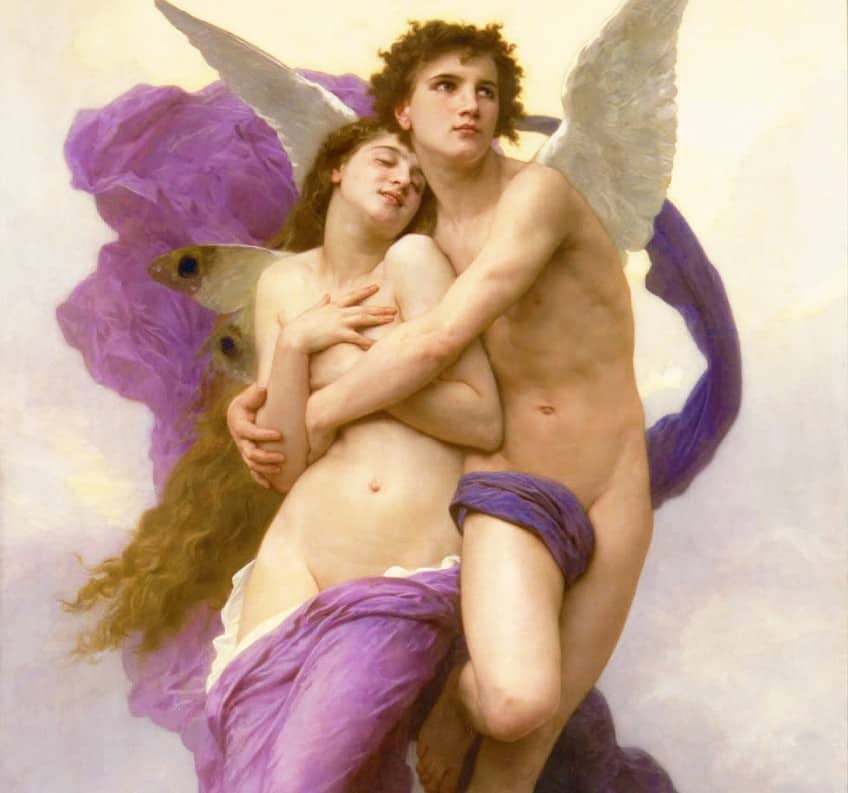
This fabric swells in a surge of wind behind the two lovers, as does Psyche’s long locks, which hang below her waist. There are a set of butterfly wings behind Psyche’s back and a pair of white angelic wings on Cupid’s back. The lower third of the composition depicts a rocky, mountainous landscape, which is below the couple as they rise into the heavens, just about to pass the tip of the mountaintop. A river appears in the landscape below.
The upper two-thirds of the painting depicts the sky with white fluffy clouds. The upper portion becomes lighter in color as the couple nears the heavens. This has also been likened to dawn and heaven resplendent with the oncoming sunshine.
Color
The colors in The Abduction of Psyche by William-Adolphe Bouguereau are light and soft purples and whites, which blend subtly with the fair skin tones of Psyche and Cupid. The landscape in the background is in varying shades of earthy browns.
There are no stark color contrasts, which creates color harmony throughout.

Texture
There is an overall smooth texture of Bouguereau’s brushwork in The Abduction of Psyche painting. He was also known for his realism, which is noticeable in the implied surface of Psyche and Cupid’s figures, the natural curves of their bodies and muscle tones, including the softer details of their hair, the angel and butterfly wings, and the finer folds of the fabric.
These softer textures are contrasted with the coarser and ragged textures of the mountains behind and below.

Line
There is a dominant vertical linearity in The Abduction of Psyche painting, which is implied by the two figures rising into the sky. This also creates directional lines and provides a sense of upward movement. The composition also consists of naturalistic lines and a gently curved line implied by Cupid and Psyche’s body postures.
This is accentuated by the left side of Cupid’s body, as his left leg is slightly bent inwards and his body creates a perfect place for Psyche, who fits in his arms.

Shape and Form
The Abduction of Psyche painting is composed of naturalistic, organic, shapes and forms (as opposed to geometric or abstract shapes and forms). These range from the figures of Psyche and Cupid to the natural landscape behind them.

Space
William-Adolphe Bouguereau creates a sense of depth and three-dimensional space through aerial or atmospheric perspective, which is noticed in the hazing and blurring of the distant background.
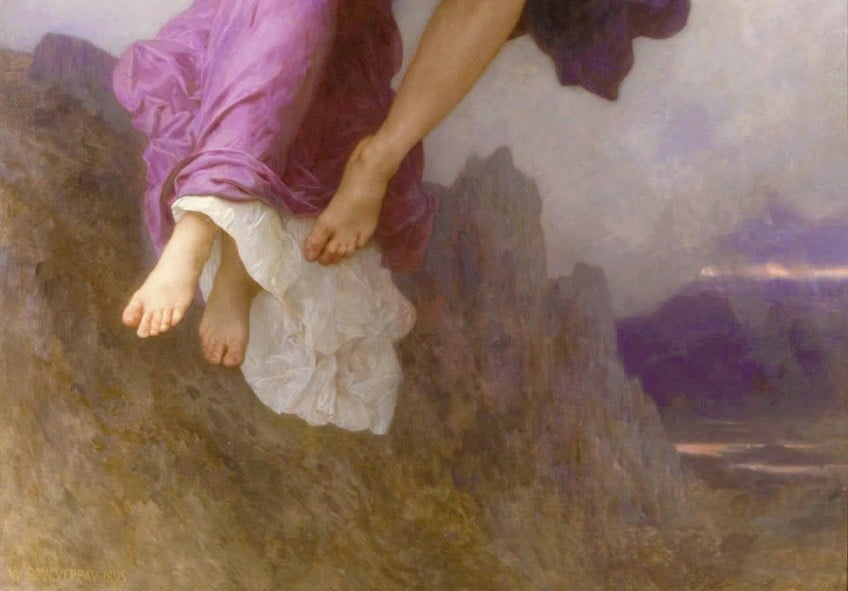
Bouguereau’s Belle and Beau
William-Adolphe Bouguereau was a classical Neoclassical artist, so to say, and he held true to his Academic style of painting, so much so that he was averse to the emerging Impressionism art style of the time. Nonetheless, his paintings were in demand during his art career, and he was popular for his often-described idealistic scenes of female figures.
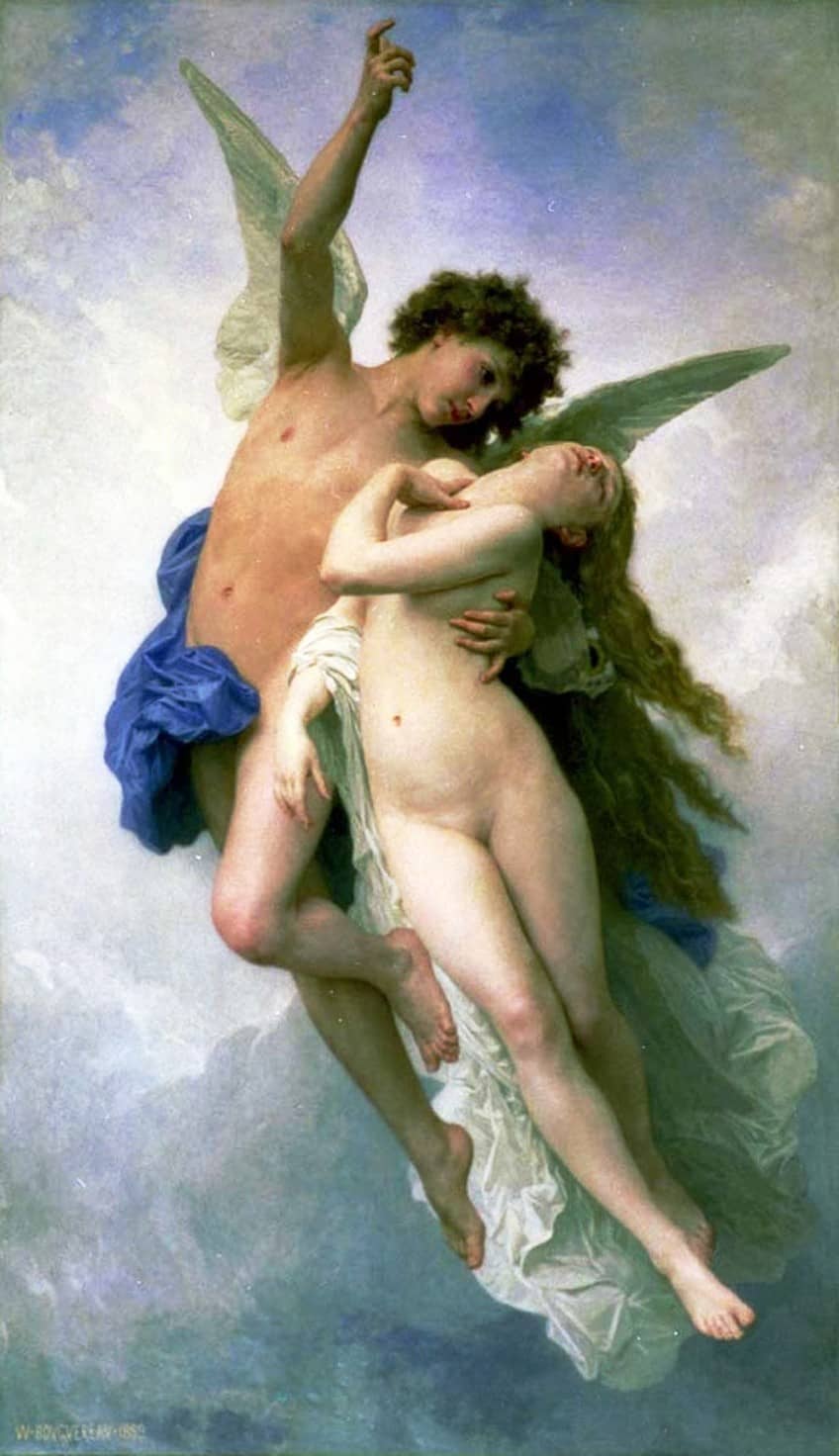
While this article explored “The Abduction of Psyche” meaning, including how William-Adolphe Bouguereau depicted his subject matter, it is also a testament to the artist’s quality of work. In a way, Bouguereau abducts our visual senses and takes us on a journey with these two heavenly lovers, Cupid and Psyche.
Frequently Asked Questions
Who Painted The Abduction of Psyche?
The Neoclassical, or Academic, painter William-Adolphe Bouguereau painted the scene of Psyche and Cupid in a loving embrace. As an oil on canvas, it measures 209 by 120 centimeters. It is reportedly part of a private collection, of which its provenance is uncertain.
What Is The Abduction of Psyche Meaning?
The painting by William-Adolphe Bouguereau depicts the Greek myth about the goddess Psyche and the god Cupid when he transported her to her new home, and ultimately saved her from marrying a monster.
What Was William-Adolphe-Bouguereau’s Art Style?
William-Adolphe Bouguereau painted in the Academic art style, focusing mostly on Neoclassicism. He was reputed for his realistic depiction of his subject matter, often focusing on mythological stories.
Alicia du Plessis is a multidisciplinary writer. She completed her Bachelor of Arts degree, majoring in Art History and Classical Civilization, as well as two Honors, namely, in Art History and Education and Development, at the University of KwaZulu-Natal, South Africa. For her main Honors project in Art History, she explored perceptions of the San Bushmen’s identity and the concept of the “Other”. She has also looked at the use of photography in art and how it has been used to portray people’s lives.
Alicia’s other areas of interest in Art History include the process of writing about Art History and how to analyze paintings. Some of her favorite art movements include Impressionism and German Expressionism. She is yet to complete her Masters in Art History (she would like to do this abroad in Europe) having given it some time to first develop more professional experience with the interest to one day lecture it too.
Alicia has been working for artincontext.com since 2021 as an author and art history expert. She has specialized in painting analysis and is covering most of our painting analysis.
Learn more about Alicia du Plessis and the Art in Context Team.
Cite this Article
Alicia, du Plessis, “The Abduction of Psyche by William-Adolphe Bouguereau – A Look.” Art in Context. July 18, 2023. URL: https://artincontext.org/the-abduction-of-psyche-by-william-adolphe-bouguereau/
du Plessis, A. (2023, 18 July). The Abduction of Psyche by William-Adolphe Bouguereau – A Look. Art in Context. https://artincontext.org/the-abduction-of-psyche-by-william-adolphe-bouguereau/
du Plessis, Alicia. “The Abduction of Psyche by William-Adolphe Bouguereau – A Look.” Art in Context, July 18, 2023. https://artincontext.org/the-abduction-of-psyche-by-william-adolphe-bouguereau/.





